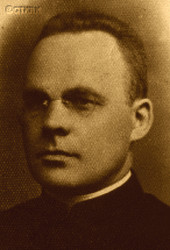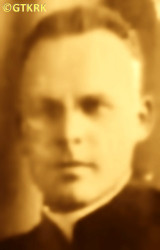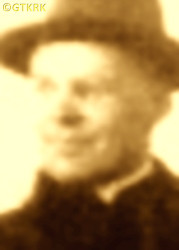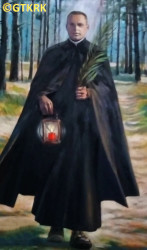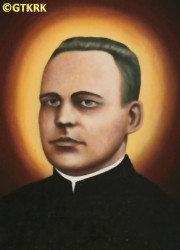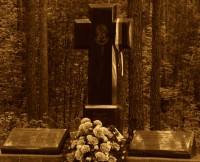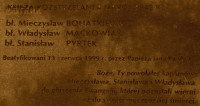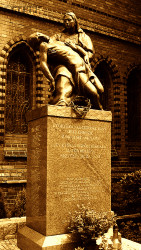Roman Catholic
St Sigismund parish
05-507 Słomczyn
85 Wiślana Str.
Konstancin deanery
Warsaw archdiocese, Poland
full list:
displayClick to display full list

searchClick to search full list by categories
wyświetlKliknij by wyświetlić pełną listę po polsku

szukajKliknij by przeszukać listę wg kategorii po polsku

Martyrology of the clergy — Poland
XX century (1914 – 1989)
personal data
religious status
blessed
surname
BOHATKIEWICZ
forename(s)
Mieczyslav (pl. Mieczysław)
beatification date
13.06.1999more on
www.swzygmunt.knc.pl
[access: 2013.05.19]

the RC Pope John Paul IImore on
en.wikipedia.org
[access: 2014.09.21]
function
diocesan priest
creed
Latin (Roman Catholic) Church RCmore on
en.wikipedia.org
[access: 2014.09.21]
diocese / province
Pinsk diocesemore on
en.wikipedia.org
[access: 2013.05.19]
Vilnius archdiocesemore on
en.wikipedia.org
[access: 2013.05.19]
RC Military Ordinariate of Polandmore on
en.wikipedia.org
[access: 2014.12.20]
date and place
of death
04.03.1942

Borok forestn. Berezvech (today: Hlybokaye)
today: Udelo ssov., Hlybokaye dist., Vitebsk reg., Belarus
more on
be.wikipedia.org
[access: 2023.01.18]
details of death
After German and Russian invasion of Poland in 09.1939, start of the World War II and start of Russian occupation moved to Vilnius diocese and took parish priest post in Pelikany.
There prob. was involved in organization of Polish clandestine resistance Union of Armed Struggle ZWZ movement (part of Polish Clandestine State).
After German attack of their erstwhile ally Russian in 06.1941 sent by Abp Jałbrzykowski beyond former Polish border, to Dryssa, where Catholic had not seen a priest for 20 years.
Prob. provided help to persecuted Jews.
Arrested by the Germans on 16.01.1943, denounced by the Ukrainian–communist.
Incarcerated in Braslaw and next transported to Berezvech (Hlybokaye) prison.
There tortured.
Had a chance to escape from prison hospital but refused not wanting to the hospital staff in danger.
Sentenced to death and executed in a nearby forest together with Fr Vladislav Maćkowiak and Stanislav Pyrtek, four captured Russian escapee soldiers from a POW camp and a baptized Jewess.
cause of death
mass murder
perpetrators
Germans
sites and events
BerezvechClick to display the description, Help to the JewsClick to display the description, Ribbentrop‐MolotovClick to display the description, Pius XI's encyclicalsClick to display the description
date and place
of birth
01.01.1904

Krykałytoday: Dunilavičy ssov., Pastavy dist., Vitebsk reg., Belarus
more on
tt.wikipedia.org
[access: 2022.08.05]
parents
BOHATKIEWICZ Stanislav
🞲 ?, ? — 🕆 01.05.1920, ?

ZIENKIEWICZ Josefa
🞲 1884, ? — 🕆 1971,
presbyter (holy orders)
ordination
23.08.1933

Pinsktoday: Pinsk city dist., Brest reg., Belarus
more on
en.wikipedia.org
[access: 2022.07.16]
Assumption of the Blessed Virgin Mary RC cathedral churchmore on
en.wikipedia.org
[access: 2025.03.14]
positions held
1941 – 1942
parish priest — Dryssatoday: Verkhnyadzvinsk, Verkhnyadzvinsk dist., Vitebsk reg., Belarus
more on
en.wikipedia.org
[access: 2022.07.16] ⋄ Nativity of the Blessed Virgin Mary RC parish
1939 – 1941
parish priest — Pelikanytoday: Milyuntsy, Opsa ssov., Braslav dist., Vitebsk reg., Belarus
more on
be.wikipedia.org
[access: 2022.07.16] ⋄ St James RC parish ⋄ Braslawtoday: Braslaw dist., Vitebsk reg., Belarus
more on
en.wikipedia.org
[access: 2021.09.29] RC deanery
1936 – 1939
vicar — Luninetstoday: Luninets dist., Brest reg., Belarus
more on
en.wikipedia.org
[access: 2021.09.02] ⋄ St Joseph RC parish ⋄ Luninetstoday: Luninets dist., Brest reg., Belarus
more on
en.wikipedia.org
[access: 2021.09.02] RC deanery — also: prefekt of schools, including King Vladislav Jagiełło's State Gimnazjum
1933 – 1936
prefect — Drohiczyntoday: Drohiczyn gm., Siemiatycze pov., Podlaskie voiv., Poland
more on
en.wikipedia.org
[access: 2020.12.11] ⋄ St Stanislav Kostka the Confessor Lower Theological Seminary, i.e. diocesan Gymnasium for Men ⋄ Holy Trinity RC parish ⋄ Drohiczyntoday: Drohiczyn gm., Siemiatycze pov., Podlaskie voiv., Poland
more on
en.wikipedia.org
[access: 2020.12.11] RC deanery
c. 1925 – 1933
student — Pinsktoday: Pinsk city dist., Brest reg., Belarus
more on
en.wikipedia.org
[access: 2022.07.16] ⋄ philosophy and theology, St Thomas Aquinas' Theological Seminary ⋄ Pinsk RC diocese
till c. 1925
student — Navahrudaktoday: Navahrudak dist., Grodno reg., Belarus
more on
en.wikipedia.org
[access: 2021.07.04] ⋄ philosophy and theology, Theological Seminary ⋄ Minsk RC diocese
others related
in death
HLEBOWICZClick to display biography Henry, KASZYRAClick to display biography George, LESZCZEWICZClick to display biography Anthony, DRONICZClick to display biography Romualdo, MACIEJOWSKIClick to display biography Boleslav, MAĆKOWIAKClick to display biography Vladislav, MASIULANISClick to display biography Adam, PYRTEKClick to display biography Stanislav, SKORKOClick to display biography Anthony, WIECZOREKClick to display biography Vladislav, MIODUSZEWSKIClick to display biography Anthony, GLAKOWSKIClick to display biography Stanislav, GODLEWSKIClick to display biography Vincent, LUBECKIClick to display biography Alexander, LUBIANIECClick to display biography Charles, MALECClick to display biography Dennis, MARCINIAKClick to display biography Isidore, RYBAŁTOWSKIClick to display biography Casimir, ŚWIATOPEŁK–MIRSKIClick to display biography Anthony
sites and events
descriptions
Berezvech: In a Basilian monastery in 1939 Russians organised a prison, mainly for Poles. In 06.1941, after German attack, Russians murdered there hundreds of prisoners. Few thousands were marched off and murdered on the way by Russian escort. After German aggression the prison was used by the new aggressors. Inmates were murdered in the monastery itself and in a nearby forest in Borek. C. 27,000 prisoners of different nationalities, mainly Polish citizens, perished. (more on: pl.wikipedia.orgClick to attempt to display webpage
[access: 2012.11.23], www.radzima.orgClick to attempt to display webpage
[access: 2013.10.05])
Help to the Jews: During World War II on the Polish occupied territories Germans forbid to give any support to the Jews under penalty of death. Hundreds of Polish priests and religious helped the Jews despite this official sanction. Many of them were caught and murdered.
Ribbentrop‐Molotov: Genocidal Russian‐German alliance pact between Russian leader Joseph Stalin and German leader Adolf Hitler signed on 23.08.1939 in Moscow by respective foreign ministers, Mr. Vyacheslav Molotov for Russia and Joachim von Ribbentrop for Germany. The pact sanctioned and was the direct cause of joint Russian and German invasion of Poland and the outbreak of the World War II in 09.1939. In a political sense, the pact was an attempt to restore the status quo ante before 1914, with one exception, namely the „commercial” exchange of the so‐called „Kingdom of Poland”, which in 1914 was part of the Russian Empire, fore Eastern Galicia (today's western Ukraine), in 1914 belonging to the Austro‐Hungarian Empire. Galicia, including Lviv, was to be taken over by the Russians, the „Kingdom of Poland” — under the name of the General Governorate — Germany. The resultant „war was one of the greatest calamities and dramas of humanity in history, for two atheistic and anti‐Christian ideologies — national and international socialism — rejected God and His fifth Decalogue commandment: Thou shall not kill!” (Abp Stanislav Gądecki, 01.09.2019). The decisions taken — backed up by the betrayal of the formal allies of Poland, France and Germany, which on 12.09.1939, at a joint conference in Abbeville, decided not to provide aid to attacked Poland and not to take military action against Germany (a clear breach of treaty obligations with Poland) — were on 28.09.1939 slightly altered and made more precise when a treaty on „German‐Russian boundaries and friendship” was agreed by the same murderous signatories. One of its findings was establishment of spheres of influence in Central and Eastern Europe and in consequence IV partition of Poland. In one of its secret annexes agreed, that: „the Signatories will not tolerate on its respective territories any Polish propaganda that affects the territory of the other Side. On their respective territories they will suppress all such propaganda and inform each other of the measures taken to accomplish it”. The agreements resulted in a series of meeting between two genocidal organization representing both sides — German Gestapo and Russian NKVD when coordination of efforts to exterminate Polish intelligentsia and Polish leading classes (in Germany called «Intelligenzaktion», in Russia took the form of Katyń massacres) where discussed. Resulted in deaths of hundreds of thousands of Polish intelligentsia, including thousands of priests presented here, and tens of millions of ordinary people,. The results of this Russian‐German pact lasted till 1989 and are still in evidence even today. (more on: en.wikipedia.orgClick to attempt to display webpage
[access: 2015.09.30])
Pius XI's encyclicals: Facing the creation of two totalitarian systems in Europe, which seemed to compete with each other, though there were more similarities than contradictions between them, Pope Pius XI issued in 03.1937 (within 5 days) two encyclicals. In the „Mit brennender Sorge” (Eng. „With Burning Concern”) published on 14.03.1938, condemned the national socialism prevailing in Germany. The Pope wrote: „Whoever, following the old Germanic‐pre‐Christian beliefs, puts various impersonal fate in the place of a personal God, denies the wisdom of God and Providence […], whoever exalts earthly values: race or nation, or state, or state system, representatives of state power or other fundamental values of human society, […] and makes them the highest standard of all values, including religious ones, and idolizes them, this one […] is far from true faith in God and from a worldview corresponding to such faith”. On 19.03.1937, published „Divini Redemptoris” (Eng. „Divine Redeemer”), in which criticized Russian communism, dialectical materialism and the class struggle theory. The Pope wrote: „Communism deprives man of freedom, and therefore the spiritual basis of all life norms. It deprives the human person of all his dignity and any moral support with which he could resist the onslaught of blind passions […] This is the new gospel that Bolshevik and godless communism preaches as a message of salvation and redemption of humanity”… Pius XI demanded that the established human law be subjected to the natural law of God , recommended the implementation of the ideal of a Christian state and society, and called on Catholics to resist. Two years later, National Socialist Germany and Communist Russia came together and started World War II. (more on: www.vatican.vaClick to attempt to display webpage
[access: 2023.05.28], www.vatican.vaClick to attempt to display webpage
[access: 2023.05.28])
sources
personal:
pl.wikipedia.orgClick to attempt to display webpage
[access: 2016.11.06], www.archibial.plClick to attempt to display webpage
[access: 2012.12.28]
bibliographical:
„Martyrology of the Polish Roman Catholic clergy under nazi occupation in 1939‐1945”, Victor Jacewicz, John Woś, vol. I‐V, Warsaw Theological Academy, 1977‐1981
„Vilnius archdiocese clergy martyrology 1939‐1945”, Fr Thaddeus Krahel, Białystok, 2017
„Pinsk Diocese in Poland Clergy and Church Register”, Pinsk diocese bishop, 1933‐1939, diocesan printing house
original images:
ksiegahonoru.salon24.plClick to attempt to display webpage
[access: 2016.11.06], www.picuki.comClick to attempt to display webpage
[access: 2020.07.31], polesie.orgClick to attempt to display webpage
[access: 2020.07.31], www.picuki.comClick to attempt to display webpage
[access: 2020.07.31], ave-maria.byClick to attempt to display webpage
[access: 2020.07.31], blogi.czarnota.orgClick to attempt to display webpage
[access: 2016.11.06], blogi.czarnota.orgClick to attempt to display webpage
[access: 2016.11.06], www.szczecin.plClick to attempt to display webpage
[access: 2014.09.21], www.ciekawepodlasie.plClick to attempt to display webpage
[access: 2020.07.31]
LETTER to CUSTODIAN/ADMINISTRATOR
If you have an Email client on your communicator/computer — such as Mozilla Thunderbird, Windows Mail or Microsoft Outlook, described at WikipediaPatrz:
en.wikipedia.org, among others — try the link below, please:
LETTER to CUSTODIAN/ADMINISTRATORClick and try to call your own Email client
If however you do not run such a client or the above link is not active please send an email to the Custodian/Administrator using your account — in your customary email/correspondence engine — at the following address:

giving the following as the subject:
MARTYROLOGY: BOHATKIEWICZ Mieczyslav
To return to the biography press below:
 Click to return to biography
Click to return to biography








